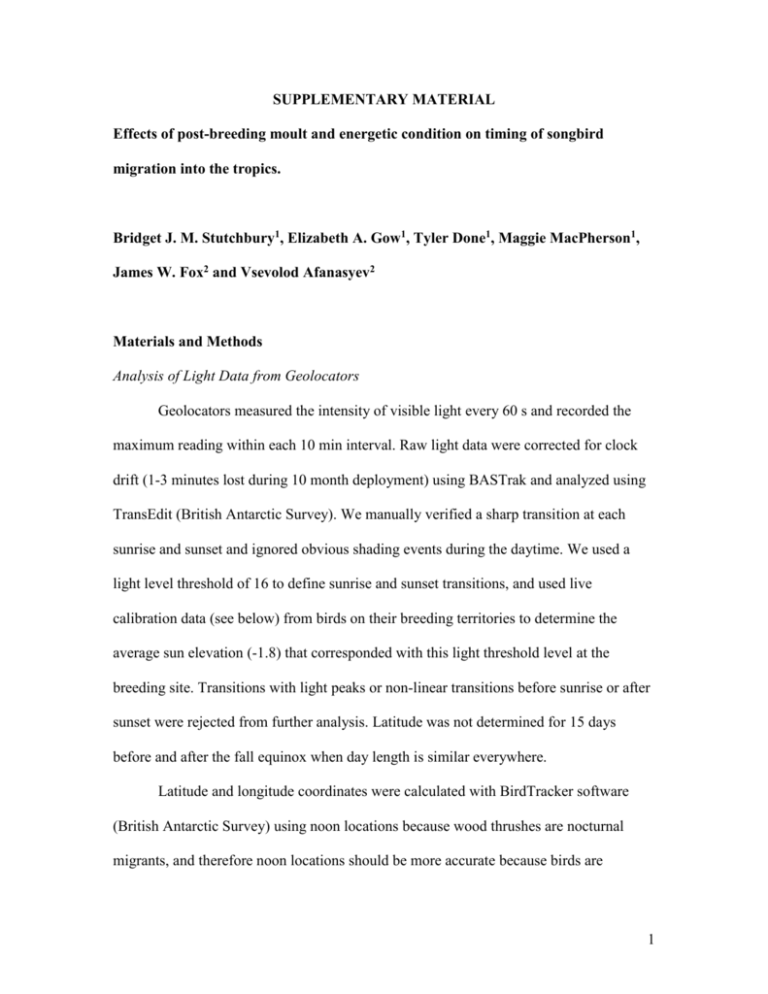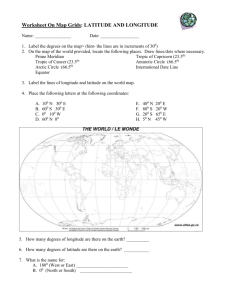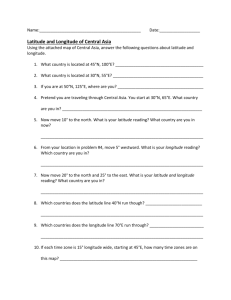Geolocator Analysis Methods for Wood Thrush
advertisement

SUPPLEMENTARY MATERIAL Effects of post-breeding moult and energetic condition on timing of songbird migration into the tropics. Bridget J. M. Stutchbury1, Elizabeth A. Gow1, Tyler Done1, Maggie MacPherson1, James W. Fox2 and Vsevolod Afanasyev2 Materials and Methods Analysis of Light Data from Geolocators Geolocators measured the intensity of visible light every 60 s and recorded the maximum reading within each 10 min interval. Raw light data were corrected for clock drift (1-3 minutes lost during 10 month deployment) using BASTrak and analyzed using TransEdit (British Antarctic Survey). We manually verified a sharp transition at each sunrise and sunset and ignored obvious shading events during the daytime. We used a light level threshold of 16 to define sunrise and sunset transitions, and used live calibration data (see below) from birds on their breeding territories to determine the average sun elevation (-1.8) that corresponded with this light threshold level at the breeding site. Transitions with light peaks or non-linear transitions before sunrise or after sunset were rejected from further analysis. Latitude was not determined for 15 days before and after the fall equinox when day length is similar everywhere. Latitude and longitude coordinates were calculated with BirdTracker software (British Antarctic Survey) using noon locations because wood thrushes are nocturnal migrants, and therefore noon locations should be more accurate because birds are 1 stationary during the day. No compensation for longitudinal movement was made when estimating latitude because birds were assumed to be stationary from sunrise to sunset. Locations that were clearly anomalous were rejected as outliers. Locations could not be determined due to uneven sunrise or sunset transitions on an average of 55 days per bird (about 20% of days). Outliers occurred on 11.7 days per bird and 60% of these outliers involved anomalous latitude estimates close to (16-25 days) the spring or fall equinox. All geolocators received a static pre-deployment (May) and post-deployment calibration (June or July) for one week in open habitat with a clear view of the horizon, to assess light sensitivity of units. Light sensitivity was virtually identical among units and was similar after deployment. Analysis of live locations for birds at our study site was used to determine the average sun elevation (BasTrak, British Antarctic Survey) that corresponds to the light level of 16 that was used to define sunrise and sunset transitions. The sun elevation, in turn, is used in BirdTracker (British Antarctic Survey) to determine location given the sun’s position on a given date at a given time. We determined the average sun elevation (n = 16) both prior to migration (1 August -15 September) and in early spring (arrival in late April or May to 15 June). There were missing values for spring due to immediate capture of one bird and premature battery failure during spring migration for two birds. Sun elevation when the light level was 16 averaged -1.8 + 0.19 (se; n = 29) at the breeding site, and this value was used for subsequent analysis. Geolocation accuracy was estimated for birds at the breeding site (41.8º N, 79.9ºW) by averaging locations of each individual in July and August, based on at least 10 days. Average estimated breeding latitude ranged from 39.1 to 43.4 (average = 41.7, n = 16) and longitude ranged from 77.8 to 80.1 (average = 78.4). Average standard error of 2 the mean was 0.60 for latitude (range 0.32-1.1) and 0.31 for longitude (range 0.19-0.45). The estimated error in identifying breeding location, by comparing geolocator estimate to true location, ranged from 14-296 km (average = 126 km, s.e. = 18.1) in latitude and 15177 km in longitude (average = 130 km, s.e. = 11.9). Differences in geolocation accuracy among individuals occupying the same breeding population likely reflect variation in vegetation density and topography among territories, and individual habitat use at sunrise and sunset. Wood thrush have high site fidelity to their winter territory, which provides a way to estimate the accuracy of winter territory locations assuming that birds return to the same location each winter. Two individuals were tracked in multiple years. The estimated location of the winter territory for the first individual was 14.3ºN 83.7ºW in 2007-8 and 14.9ºN 83.7 ºW in 2008-9, a difference of 50 km. For the second bird, tracked three consecutive years, territory location was 15.4ºN 84.6ºW (2007-8), 15.6ºN 85.1ºW (20089; 55km) and 17.0ºN 84.8ºW (2009-10; 175 km). The day-to-day accuracy for a given individual at the same location is far more variable as a result of weather (cloud, fog, rain) that affects light levels around sunrise and sunset, as well as daily differences in habitat use and behaviour. At the breeding site, for individuals tagged in late June or early July (n = 5) and had many sampling days, the standard deviation of latitude for an individual ranged from 1.5-2.8 (average 2.1 degrees) and for longitude ranged from 1.01-1.6 (average 1.3 degrees). This corresponds to a daily error of 230 km in latitude and 105 km in longitude. For winter territory location (n = 14), the standard deviation averaged 3.5 degrees (range 2.6-4.8) in latitude and 1.3 3 degrees (range 1.0-1.7) in longitude. This corresponds to a daily location error of 390 km in latitude, and 140 km in longitude. Given the accuracy of geolocators, we could not distinguish short distance movements on fall migration from daily variation in location of stationary birds. Movements away from the breeding site, and from one stopover location to another, were defined as long distance movements (> 250 km latitude, > 150 km longitude) that were consistent with fall migration. Movements during the fall equinox, when latitude could not be determined, were based on longitude alone therefore a bird moving due south during this period would not be detectable until early October when geographic variation in day length resumed. Locations that remained consistent, and within the location error of stationary birds, for two or more days were defined as stopover locations. Arrival on the winter territory was considered to have occurred when the latitude and longitude ceased to shift in a direction consistent with fall migration, fluctuated around a narrow range of values consistent with a stationary bird, and fluctuated around a similar value until the onset of northward migration in spring. During presumed stopovers and while stationary during winter, location was determined by calculating average latitude and longitude during the period. The number of stopover days versus flight days and the exact timing of long distance movements could not always be determined due to sporadic missing days when shading events occurred near dawn or dusk and location. The intermediate date was used if movements occurred when locations could not be determined from light data. 4 5









